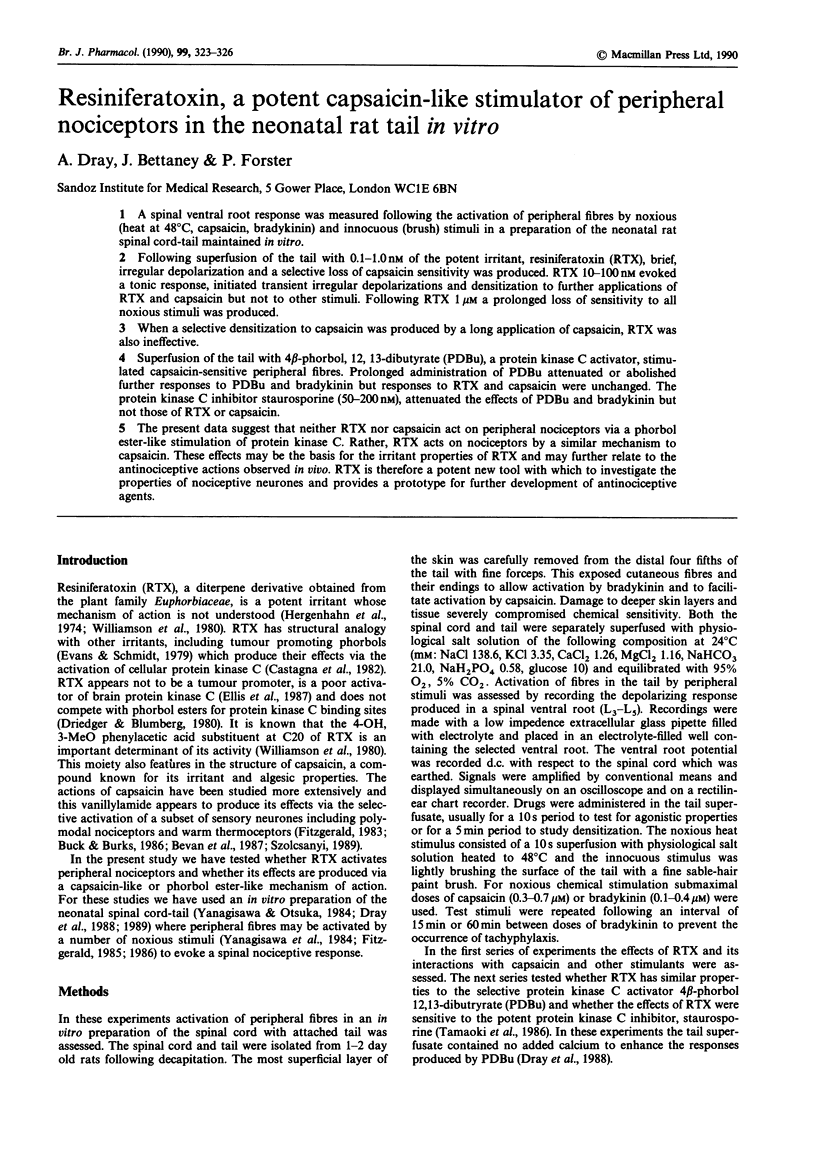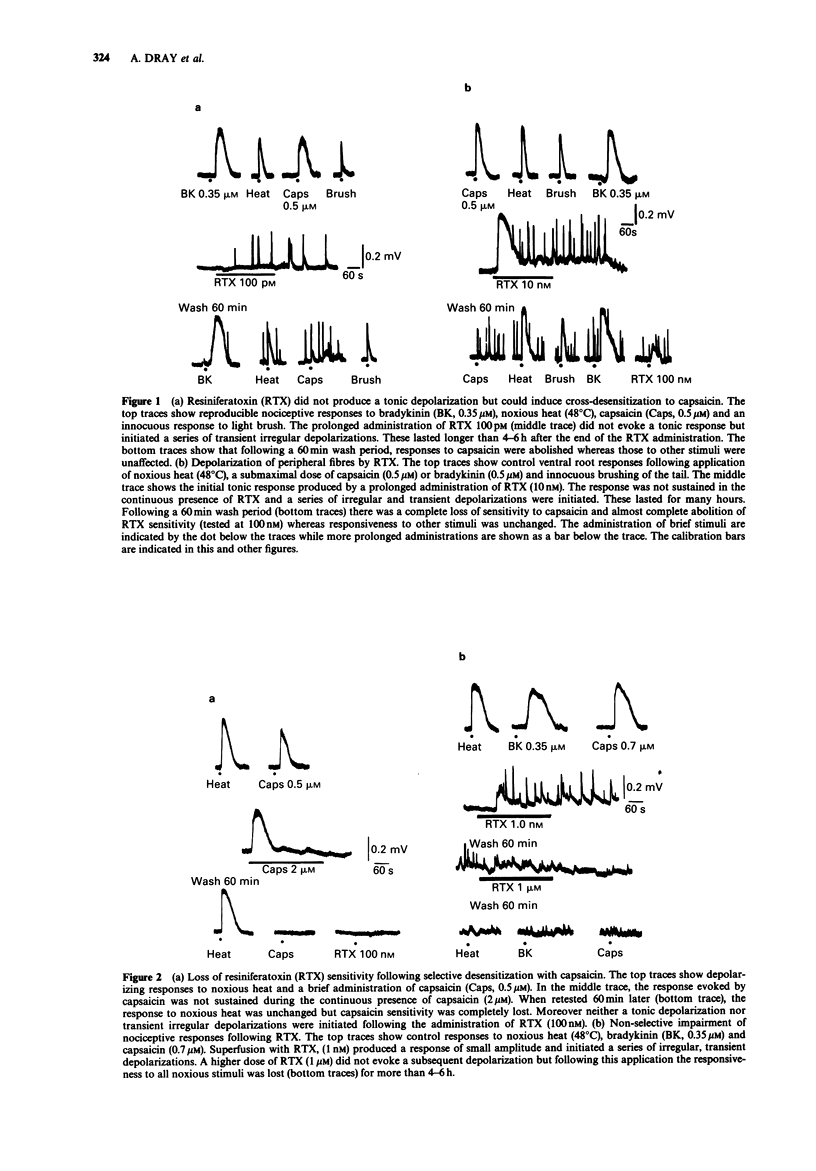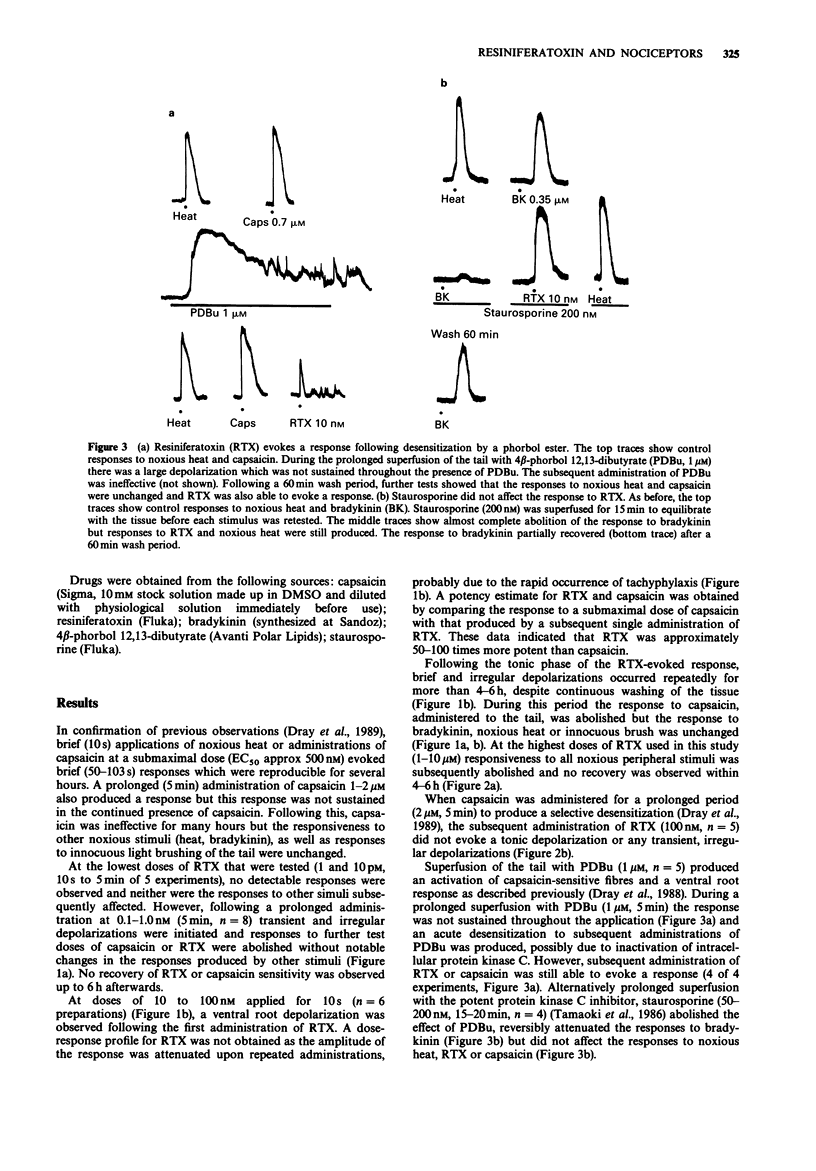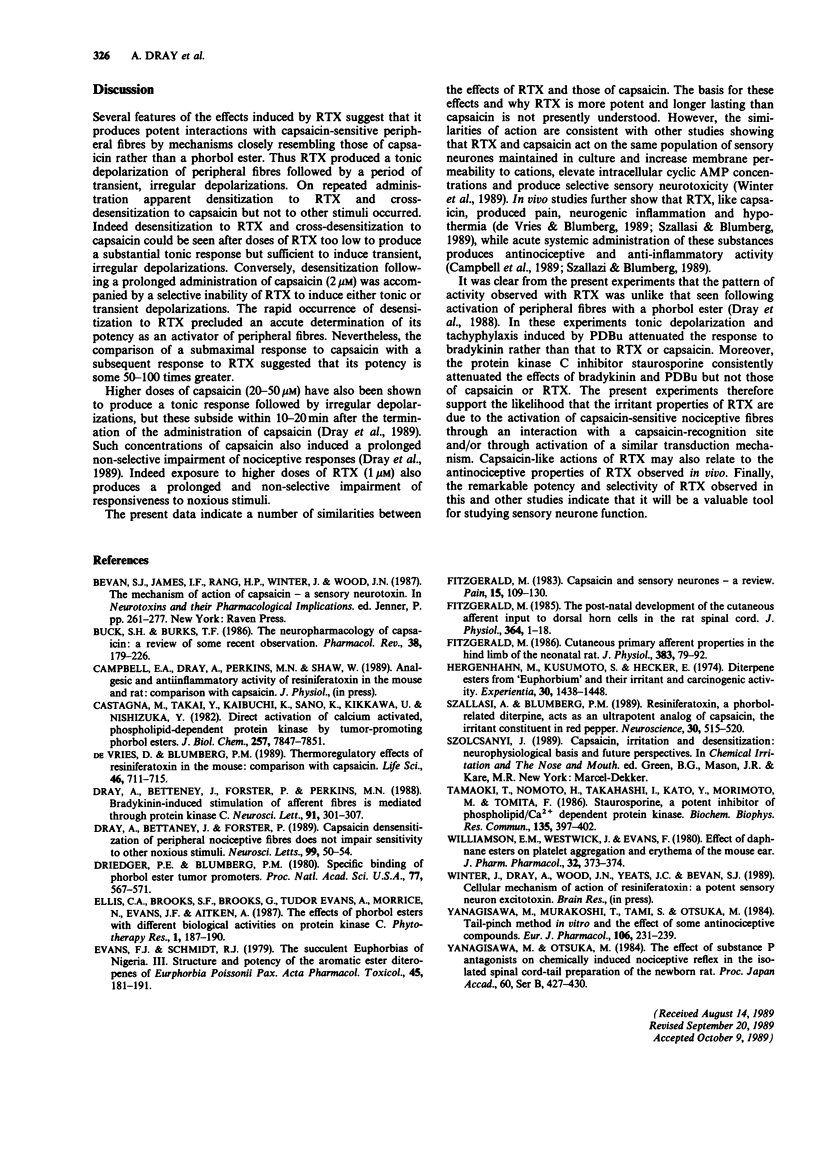Abstract
1. A spinal ventral root response was measured following the activation of peripheral fibres by noxious (heat at 48 degrees C, capsaicin, bradykinin) and innocuous (brush) stimuli in a preparation of the neonatal rat spinal cord-tail maintained in vitro. 2. Following superfusion of the tail with 0.1-1.0 nM of the potent irritant, resiniferatoxin (RTX), brief, irregular depolarization and a selective loss of capsaicin sensitivity was produced. RTX 10-100 nM evoked a tonic response, initiated transient irregular depolarizations and densitization to further applications of RTX and capsaicin but not to other stimuli. Following RTX 1 microM a prolonged loss of sensitivity to all noxious stimuli was produced. 3. When a selective densitization to capsaicin was produced by a long application of capsaicin, RTX was also ineffective. 4. Superfusion of the tail with 4 beta-phorbol, 12, 13-dibutyrate (PDBu), a protein kinase C activator, stimulated capsaicin-sensitive peripheral fibres. Prolonged administration of PDBu attenuated or abolished further responses to PDBu and bradykinin but responses to RTX and capsaicin were unchanged. The protein kinase C inhibitor staurosporine (50-200 nM), attenuated the effects of PDBu and bradykinin but not those of RTX or capsaicin. 5. The present data suggest that neither RTX nor capsaicin act on peripheral nociceptors via a phorbol ester-like stimulation of protein kinase C. Rather, RTX acts on nociceptors by a similar mechanism to capsaicin. These effects may be the basis for the irritant properties of RTX and may further relate to the antinociceptive actions observed in vivo.(ABSTRACT TRUNCATED AT 250 WORDS)
Full text
PDF



Selected References
These references are in PubMed. This may not be the complete list of references from this article.
- Buck S. H., Burks T. F. The neuropharmacology of capsaicin: review of some recent observations. Pharmacol Rev. 1986 Sep;38(3):179–226. [PubMed] [Google Scholar]
- Castagna M., Takai Y., Kaibuchi K., Sano K., Kikkawa U., Nishizuka Y. Direct activation of calcium-activated, phospholipid-dependent protein kinase by tumor-promoting phorbol esters. J Biol Chem. 1982 Jul 10;257(13):7847–7851. [PubMed] [Google Scholar]
- Dray A., Bettaney J., Forster P. Capsaicin desensitization of peripheral nociceptive fibres does not impair sensitivity to other noxious stimuli. Neurosci Lett. 1989 Apr 24;99(1-2):50–54. doi: 10.1016/0304-3940(89)90263-2. [DOI] [PubMed] [Google Scholar]
- Dray A., Bettaney J., Forster P., Perkins M. N. Bradykinin-induced stimulation of afferent fibres is mediated through protein kinase C. Neurosci Lett. 1988 Sep 12;91(3):301–307. doi: 10.1016/0304-3940(88)90697-0. [DOI] [PubMed] [Google Scholar]
- Driedger P. E., Blumberg P. M. Specific binding of phorbol ester tumor promoters. Proc Natl Acad Sci U S A. 1980 Jan;77(1):567–571. doi: 10.1073/pnas.77.1.567. [DOI] [PMC free article] [PubMed] [Google Scholar]
- Evans F. J., Schmidt R. J. The succulent euphorbias of Nigeria. III. Structure and potency of the aromatic ester diterpenes of Euphorbia poissonii Pax. Acta Pharmacol Toxicol (Copenh) 1979 Sep;45(3):181–191. doi: 10.1111/j.1600-0773.1979.tb02380.x. [DOI] [PubMed] [Google Scholar]
- Fitzgerald M. Capsaicin and sensory neurones--a review. Pain. 1983 Feb;15(2):109–130. doi: 10.1016/0304-3959(83)90012-x. [DOI] [PubMed] [Google Scholar]
- Fitzgerald M. Cutaneous primary afferent properties in the hind limb of the neonatal rat. J Physiol. 1987 Feb;383:79–92. doi: 10.1113/jphysiol.1987.sp016397. [DOI] [PMC free article] [PubMed] [Google Scholar]
- Fitzgerald M. The post-natal development of cutaneous afferent fibre input and receptive field organization in the rat dorsal horn. J Physiol. 1985 Jul;364:1–18. doi: 10.1113/jphysiol.1985.sp015725. [DOI] [PMC free article] [PubMed] [Google Scholar]
- Hergenhahn M., Kusumoto S., Hecker E. Diterpene esters from 'Euphorbium' and their irritant and cocarcinogenic activity. Experientia. 1974 Dec 15;30(12):1438–1440. doi: 10.1007/BF01919683. [DOI] [PubMed] [Google Scholar]
- Szallasi A., Blumberg P. M. Resiniferatoxin, a phorbol-related diterpene, acts as an ultrapotent analog of capsaicin, the irritant constituent in red pepper. Neuroscience. 1989;30(2):515–520. doi: 10.1016/0306-4522(89)90269-8. [DOI] [PubMed] [Google Scholar]
- Tamaoki T., Nomoto H., Takahashi I., Kato Y., Morimoto M., Tomita F. Staurosporine, a potent inhibitor of phospholipid/Ca++dependent protein kinase. Biochem Biophys Res Commun. 1986 Mar 13;135(2):397–402. doi: 10.1016/0006-291x(86)90008-2. [DOI] [PubMed] [Google Scholar]
- Williamson E. M., Westwick J., Evans F. J. The effect of daphnane esters on platelet aggregation and erythema of the mouse ear. J Pharm Pharmacol. 1980 May;32(5):373–374. doi: 10.1111/j.2042-7158.1980.tb12943.x. [DOI] [PubMed] [Google Scholar]
- Yanagisawa M., Murakoshi T., Tamai S., Otsuka M. Tail-pinch method in vitro and the effects of some antinociceptive compounds. Eur J Pharmacol. 1984 Nov 13;106(2):231–239. doi: 10.1016/0014-2999(84)90710-6. [DOI] [PubMed] [Google Scholar]
- de Vries D. J., Blumberg P. M. Thermoregulatory effects of resiniferatoxin in the mouse: comparison with capsaicin. Life Sci. 1989;44(11):711–715. doi: 10.1016/0024-3205(89)90382-2. [DOI] [PubMed] [Google Scholar]


